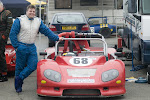Well I've had my shiny new RIMs fitted with the A048rs that are mandatory for the RGB series, I've gone for 195/55/R15s for the fronts but on the advice of George Polley I've gone for 205/50/R15s for the rears as he thinks that the wider tyre can help counter any tail happiness in the car. Although as I later found out they also lighten your wallet by an additional £20+ quid per corner :-(.
So in the interests of completeness I've weighed both of the different tyre sizes.

The 195/55/R15s ft weigh in at 13 Kilos complete, the 205/50/R15s tip the scales at 14 Kilos. Given that the rims weigh in at 5kg each that puts the tyre weights as 8Kg for the 195/55s and 9Kg for the 205/50s.

This is one expensive stack of rubber and alloy.
The other things that arrived today are the conversion studs for the wheel hubs.
One of my pet s are wheels that are fitted with wheel bolts rather than studs and wheel nuts. I've trapped my fingers between rims and suspension units more than once while rotating a wheel on the central hub boss trying to line up the bolt holes.
The EVO hubs are designed to take Wheel bolts that screw into threaded holes. So I've sourced these special conversion studs that screw into the bolt holes and are thread locked in place. You can then use normal wheel nuts to hold the wheels on, and the wheels sit safely on the studs while you get the nuts started hopefully avoiding trapped fingers.

The Studs are M12x1.5 and are 50mm overall length. I got them from http://www.trackstore.co.uk and they are 80p each. They are also available from Demon Tweeks but are 1.60 each. So now we're ready to sit the EVO on her own wheels and Clam can have his alloys back. Thanks Clem.
So I sat the car up on the quick lift jack, removed the front offside wheel and started fitting the conversion studs. Basically I just locked two wheel nuts together onto the stud, added a generous portion of lock-tight and simply wound the conversion stud into the hub. The unthreaded central portion bites into the threads and helps tighten stud. While I wheel bolts, I'm also aware that wheel studs are normally splined into the hub, so I'm a little concerned that the conversion studs may loosen and undo. I've therefore marked an indelible line across the face of each stud, the lines all point to the centre, so any loosening will be instantly visible as the lines will move.
 Next I moved on to the front OS hub and discovered this horror. The OS hub carrier is ed :-(. It looks like the has been developing for some time and is circumferential around the outer edge of the bearing housing. It looks like I'm going to need a new upright, Ho Hum. So rather disheartened I fitted the conversion studs and the SuperLeggara.
Next I moved on to the front OS hub and discovered this horror. The OS hub carrier is ed :-(. It looks like the has been developing for some time and is circumferential around the outer edge of the bearing housing. It looks like I'm going to need a new upright, Ho Hum. So rather disheartened I fitted the conversion studs and the SuperLeggara. Oh I forgot the other thing I managed to do today was degrease and spray paint the diff carrier.

At this stage I was called to help my friend Duncan fit a new cambelt to his Carlton so there will be no further progress today.




















